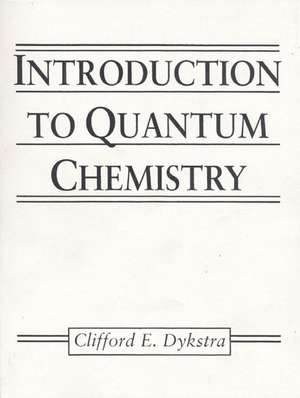Introduction to Quantum Chemistry
Autor Clifford E. Dykstraen Limba Engleză Paperback – 30 noi 1993
Preț: 509.47 lei
Preț vechi: 628.98 lei
-19% Nou
Puncte Express: 764
Preț estimativ în valută:
97.48€ • 102.06$ • 80.66£
97.48€ • 102.06$ • 80.66£
Carte indisponibilă temporar
Doresc să fiu notificat când acest titlu va fi disponibil:
Se trimite...
Preluare comenzi: 021 569.72.76
Specificații
ISBN-13: 9780137012930
ISBN-10: 0137012934
Pagini: 301
Dimensiuni: 178 x 234 x 13 mm
Greutate: 0.46 kg
Ediția:1
Editura: Pearson
Locul publicării:Upper Saddle River, United States
ISBN-10: 0137012934
Pagini: 301
Dimensiuni: 178 x 234 x 13 mm
Greutate: 0.46 kg
Ediția:1
Editura: Pearson
Locul publicării:Upper Saddle River, United States
Descriere
A supplemental text for either a junior-/senior-level course in quantum chemistry and spectroscopy or the first half of a second semester physical chemistry sequence, which begins with quantum chemistry. One year of basic calculus required.
Dykstra offers a concise, up-to-date, and non-intimidating introduction to one of the most challenging subjects of undergraduate chemistry majors. His presentation of formal elements of quantum theory and the analysis for specific problems in infrared spectroscopy, electronic structure, and magnetic resonance is both readable and rigorous.
Dykstra offers a concise, up-to-date, and non-intimidating introduction to one of the most challenging subjects of undergraduate chemistry majors. His presentation of formal elements of quantum theory and the analysis for specific problems in infrared spectroscopy, electronic structure, and magnetic resonance is both readable and rigorous.
Cuprins
1. Introduction.
Classical and quantum physics. Theory and experiment.
2. Classical Mechanics.
Equations of motion. The classical harmonic oscillator. Motion through several degrees of freedom. Harmonic vibration of many particles.
3. Quantum Mechanics—I.
Quantum phenomena. Wave character. Operators. The harmonic oscillator. The probability density. The particle-in-a-box problem. Particles and potentials.
4. Quantum Mechanics—II.
Hermitian operators. Simultaneous eigenfunctions. Multidimensional problems and degeneracy. Variation theory. Perturbation theory. Time dependence and transitions. Matrix methods for linear variation theory. First-order degenerate perturbation theory. Angular momentum operators and eigenfunctions. The rigid rotator. Coupling of angular momenta.
5. Vibrational-Rotational Spectroscopy.
Molecular spectroscopy. Vibration and rotation of a diatomic. Vibrational anharmonicity. Selection rules and spectra. Rotational spectroscopy. The harmonic picture of polyatomic vibrations. Polyatomic vibrational spectroscopy.
6. Electronic Structure.
The hydrogen atom. Properties of the radial functions. Orbital and spin angular momentum. Atomic orbitals and hydrogen atom states. Orbital picture of the elements. Term symbol states of many- electron atoms. The Born-Oppenheimer approximation. Antisymmetrization of electronic wavefunctions. The molecular orbital picture. Visible- ultraviolet spectra of molecules. Electron correlation and bond breaking.
7. Magnetic Resonance Spectroscopy.
Nuclear spin states. Nuclear spin-spin coupling. Electron spin resonance spectra. Magnetic resonance imaging.
8. Appendices.
1. Matrix algebra. 2. Curve fitting. 3. Table of integrals. 4. Table of atomic masses and nuclear spins. 5. Fundamental constants and units conversion.
Solutions to Selected Chapter Exercises.
Subject Index.
Caracteristici
- brief and inexpensive; this is a 300 page supplemental text.
- makes consistent use of the one-dimensional oscillator to model molecular vibration and to introduce quantum mechanical methods and applications.
- develops quantum mechanics to the point of predicting and interpreting spectra so students learn the connection between quantum mechanical analysis and measurements made in the laboratory.
- provides descriptive information about certain advanced topics to acquaint students with what lies ahead.
- includes exercises at the end of each chapter that highlight essential points, as well as worked solutions (to selected problems) at the end of the text.
